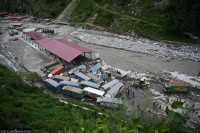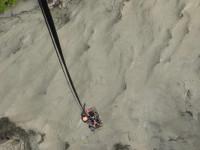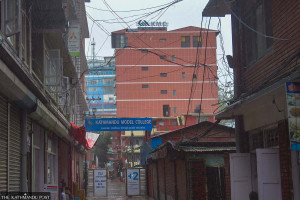Climate & Environment
Wetlands support life, livelihood and biodiversity, but they remain ignored
Encroachment, pollution and growth of invasive plants are threatening the country’s wetlands, experts say.
Chandan Kumar Mandal
Nepal’s valuable wetlands are under threat, mainly from anthropogenic activities like encroachment, pollution, unsustainable harvesting and haphazard construction along the wetland areas, according to experts
On the eve of the World Wetlands Day, which is celebrated on February 2 every year, experts stressed the need for preserving wetland areas that provide water for local communities and sustain biodiversity.
“Wetlands across the country are facing several threats. Locally, they are facing encroachment. Pollution from nearby settlements and industries are disposed of in wetlands, which disturbs the aquatic ecosystem,” Hem Sagar Baral, a biodiversity expert, told the Post. “Unsustainable harvesting of wetland resources and fishing practices with nets and explosives are also causing adverse impacts on the health of wetlands. ”
Nearly 5.5 percent of Nepal’s total area is covered by wetlands, which has rich ecological, economic and socio-cultural significance.
Nepal’s ten wetlands of international significance have been enlisted as the Ramsar Site. As its commitment to protecting its wetlands, Nepal signed the Ramsar Convention on December 17, 1987.
However, growing disturbance from human activities has posed challenges for protecting these valuable sites.
According to Haribhadra Acharya, spokesperson for the Department of National Park and Wildlife Conservation, the government body responsible for protecting wildlife as well as Ramsar sites, wetlands across the country are threatened on different levels.
“Wetland sites outside protected park areas are threatened by encroachment while those within parks are facing problems caused by pollution due to tourism activities,” said Acharya.
According to Acharya, who is also an ecologist, wetlands like Gosaikunda lake, Rara lake and Beeshajari lake are facing pollution threats due to growing tourism activities while Jagdishpur lake and Ghodaghodi lake are being impaired by development pressure.
This year’ world wetland day theme is ‘wetlands and water’, showing a connection of wetlands, water and life.
Wetlands are rich sources of environmental services like fresh water for drinking, and irrigation for food production, aquatic plants and organisms.
Of total available water on earth, only 2.5 percent of water is freshwater whereas less than one percent is usable. Wetlands like rivers, lakes and swamps are essential surface water sources for humans and other species.
“Wetlands provide direct benefits from drinking water, support livelihood and recreational activities and sustain biodiversity,” said Baral, the biodiversity expert. “It also supports vegetation composition. If the planet Earth is called a living planet, it is because we have water in it. Water is life and wetlands provide water for all living beings.”
Besides capturing and storing rainwater and recharging groundwater aquifers, wetlands also regulate water quantity and supply by releasing water at the time of need.
Wetlands also play a crucial role in improving water quality by absorbing pollutants and provide protection from floods and storms with each acre of wetland absorbing up to 1.5 million gallons of floodwater, according to a factsheet of Ramsar.
Bharat Babu Shrestha, an associate professor with the Central Department of Botany at Tribhuvan University, said wetlands are called the supermarket for biodiversity, for they offer a variety of environmental services and support livelihood.
“Wetlands are also called the kidney of nature as it purifies water and turns it into freshwater,” said Shrestha. “However, these vital sites are facing overexploitation from humans.”
Researchers like Baral and Shrestha say existing wetlands, which are facing the threat of encroachment and other human activities, are also facing challenges from invasive plants and accelerated eutrophication.
Eutrophication is the process of excessive plant growth and algae bloom due to the increased availability of nutrient fertilisers, which ultimately leaves dramatic consequences for drinking water sources, fisheries, and recreational water bodies as a result of oxygen depletion.
“On the one hand, pesticides used for agricultural purposes and industrial waste are being released into wetlands, polluting the water. On the other, excess nutrients are speeding up the eutrophication process, disturbing the whole aquatic ecosystem,” said Shrestha.
Nearly 40 percent of the world’s species live in wetlands, with 200 new fish species discovered in freshwater wetlands annually.
Nearly 90 percent of the world’s wetlands have been lost since the 1700s and those remaining are disappearing three times faster than forests. Likewise, 25 percent of all wetland species and 1 in 3 freshwater species face extinction. Global warming is reducing surface and groundwater in already dry regions, which will increase further water stress and be resulting in increasing competition for water.
Despite wetlands’ massive contribution to nature and sustaining human society, it has not received required attention that it deserves, according to researchers.
“Hardly any attention has been given to the management of wetlands which provides water, food, socio-economic activities, and biodiversity conservation. If only there were researches on the loss of biodiversity in our wetlands, we would know what we have already lost,” said Shrestha.
Loss of biodiversity in wetland areas is already being seen as the waterbird population in the country is declining.
A recent count of waterbirds in the country’s wetlands has shown that the number of aquatic birds has gone down this year, which is attributed to the degradation of wetlands.
Baral, who commissioned the census based in five Ramsar sites, said the country’s wetlands and their biodiversity were in poor state.
“The worst of them was Jagdishpur, where the waterbird population has declined to 12,000 from 18,000 last year,” said Baral. “Waterbird population in Beeshhajari, Ghoda Ghodi and Koshi Tappu has also decreased over the years. Management of these sites, where there are disturbances, is not happening properly.”
According to Baral, construction, pollution and other human activities are deteriorating the quality of the country’s wetland sites.
“While we are searching for water on Mars, we have forgotten the value of wetlands that provide water,” said Baral. “We have been taking these water resources for granted.”




 20.48°C Kathmandu
20.48°C Kathmandu













